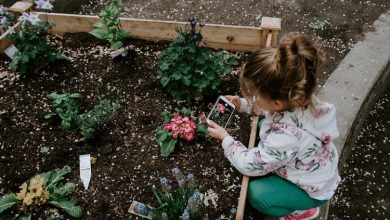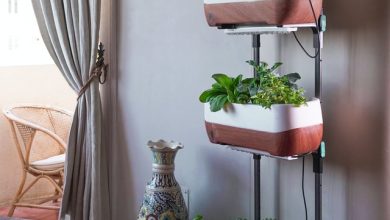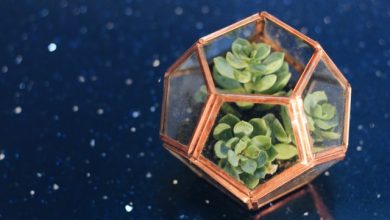How to Design a Tea Garden

Gardens are not just for growing things; while that’s certainly one of their main purposes, gardens can also provide a space where we can sit back, relax, and enjoy the beauty of the outdoors.
With the right garden design, any gardener can create an oasis that speaks to their style and preferences. Fortunately, there are a plethora of garden designs that can be incorporated into any space with a little imagination and some hard work.
One of the garden designs that has been getting more popular is the tea garden design. This kind of style speaks to gardeners who love a quiet, serene space where they might escape from the busy world and mediate over a soothing cup of tea. Some of the traditional designs of the tea garden are what make it so special, and you can easily incorporate the basic design in any space.
If you want to know how to create a tea garden, consider the following tips to create the Zen space you’ve been hoping for.
History of the Tea Garden
Not surprisingly, a tea garden refers to a garden that is designed around the act of tasting, growing, and enjoying different teas. This kind of garden is exceptionally popular in Japan, where the cultivation and drinking of tea have been popular for centuries.
The tea garden has been a part of Japanese culture since the 16th century. Sen no Rikyu was known as the very first Tea Master, and he was able to establish what a true tea garden should incorporate to provide the full experience.
In Japan, drinking tea is a part of a category known as the high arts, which also includes flower arranging, haiku, and landscape gardening. The Japanese tea garden is meant to allow a gardener to spend their lifetime honing their talents and mastering the various types of high arts they take part in.
Over time, it is believed that a gardener can become a gardening master. They will be responsible for passing down all of the knowledge and traditions they have obtained over the years in their own garden.
The tea garden combines the two main high arts of gardening and serving tea. Additionally, this kind of space should include a space where a Japanese tea ceremony can take place. In this location, a stylized ritual will take place that includes preparing and serving tea.
Types of Tea Gardens
Naturally, anyone can enjoy their tea in their garden and call it a “tea garden.” However, based on Japanese tradition, there are three main types of tea gardens.
These three garden designs are determined by the various spaces they include. Depending on how you travel through and experience the garden, you’ll be in one of three tea garden designs: The first has no specific name, the second is called niju-roji, and the third is called taju-roji.
Unnamed Garden
The unnamed garden is the most basic of the tea garden designs, which is probably why it lacks a specific category. This kind of garden would include the central tea house, surrounded by a garden that incorporated simple plants and designs. Visitors would only need to walk a short distance through this garden to enter the teahouse for the ceremony.
Niju-Roji Garden
Niju-roji is the second garden design, which would have the central tea house, an inner garden, and an outer garden surrounding that. There would also be a pathway between the two different gardens, leading from one to the other. This specific design is meant to symbolize the visitor exiting the outside world, and coming into a special place of contemplation and relaxation.
Taju-Roji Garden
The taju-roji design is the third garden design, with an additional garden installment in addition to the outer and inner gardens. This would be incorporated to help prepare visitors before they entered into the sanctuary of the teahouse.
Components of the Tea Garden

Simplicity
The idea of a traditional tea garden is to gently guide visitors from the busy, outside world into the quiet and contemplative state of the tea gardens. Naturally, one needs time to make the full transition from the hustle and bustle of their ordinary life, thus the more sections to travel before making to the teahouse, the better.
In order to create that calming effect in visitors, the tea garden must not be too overwhelming or distracting. That being said, sticking to basic green colors is one of the main components of a tea garden.
The foliage and plants used should not be obviously maintained, and there shouldn’t be too much additional color incorporated. Plants with large flowers or shocking colors are not encouraged for a tea garden.
Additionally, the smell of the garden should be simple and enjoyable. Anything too fragrant can be distracting and take the visitor off of their course. The tea garden needs to incorporate organized, clean lines and simple greenery to create a calming effect.
Barrier
As mentioned, the more elaborate tea gardens will have more than one space outside of the actual teahouse. These layers allow the visitor to prepare for the tea ceremony properly.
One of the components of the tea garden is a barrier between the different gardens, specifically between the outer garden and the inner garden. This is a barrier that can be as simple or as elaborate as you want, but it makes it clear what portion of the process you are in.
This might be a stone wall, a wooden fence, or perhaps even trimmed bushes. The idea is not to separate them completely; you should still be able to physically see the next component of the garden.
Entrance
This barrier should also have an entrance, which will lead visitors from one step of the process to the next. In some traditional designs, the entrance from one space to the next will have some sort of covered area, arbor, or arch.
This helps to signify crossing to the next area. It can be made from wood, vines, bamboo, birch pieces, etc. It doesn’t matter what you choose to create your entranceway out of, so long as it doesn’t gather too much attention and works with the style of the rest of the garden.
The Outer Garden
The outer garden is going to be the more manicured of the garden aspects. It often includes green-only colors; evergreen plants are commonly implemented. The area should feel controlled since this is the first step in going from the busy world to a calm space.
The outer garden will feel woodsy and natural, and there will be a path leading into the inner garden. Keep in mind, this is where your barrier and entrance will be as well. The outer garden normally boasts a flat ground, usually made with tiles of some sort.
Pathways can also be made from wood planks or stones. There is no rule as to how long your outer garden path is; it should be long enough that you always feel prepared for the second step. If you’d like, you can add some lanterns or small lights to lead the way when using the garden at night.
No showy plants should be used here; save distracting plants for other garden designs.
Cleansing Station
If possible, it’s ideal to incorporate a cleansing station between the inner and outer gardens. This component of the tea garden design is a traditional feature that symbolizes the cleansing of a person before they go to the tea ceremony.
In original designs, the cleansing area was a water feature that included a basin of some sort for washing your face and hands. Additionally, it would be low enough to require visitors to be on their hands and knees as a sign of respect.
Naturally, you can incorporate this aspect however you’d like. Water features are always a welcome feature in gardens, as they always encourage a feeling of calm and serenity.
The Inner Garden
The inner garden welcomes visitors to feel close to nature; that being said, materials used are natural and simple. Nothing in the inner garden should seem hand-made or unnatural.
The arrangement of the plants and trees in the inner garden should be designed in a way that makes them seem like they have always been there and chose their place. The outer garden tends to be sunny, while the inner garden should exhibit a shady space.
Canopy-style trees will help with this; their large leaves will block the sun and immediately make the space feel different than the previous one.
Garden designers might also incorporate moss along the ground, which entices people to take off their shoes and enjoy the experience barefoot. A moss-colored ground will also encourage less of a concrete, man-made look.
The Teahouse
The teahouse is the star of this garden, and visitors will have been slowly prepared for this part of the journey through your other garden spaces.
While it is the main event, the teahouse should boast the same level of simplicity and natural elements as the rest of the space. You can be as creative as you’d like with this space; it can be a simple nine foot by nine foot space with bamboo walls and ceilings, or you can create a unique shape that flows with the garden space.
Generally, the tea house blends in with the environment and allows you to feel like you’re still outside even when you’re in the covered house. This means open doors, fresh breeze, and views of the garden. You may have some furniture inside or perhaps floor cushions for meditation.
Sometimes scrolls decorate the walls of a teahouse, often covered in various pieces of wisdom or popular proverbs.
The teahouse should also include a prep area for the person who is preparing and serving your tea. The teahouse is the only place where it is acceptable to incorporate a flowering plant or incense.

Growing Tea in Your Tea Garden
Whether you choose to grow actual tea plants is up to you; however, it does add to the experience of enjoying teas that have been harvested in the very same location.
The great thing about growing tea is that you have so many options to choose from. You can choose something flavorful or earthy, strong or light. If you have space to plant a variety of teas, you’ll have even more options to offer when people visit your teahouse!
China is home to the tea plant, but it can and is grown in many tropical and temperate areas of the world. If you live in these hotter areas you will have an easy time getting your tea plants to grow well; fortunately, tea plants can also grow in some cooler regions.
Based on the USDA zones, tea plants can be grown in zones 7-11. Tea plants in these zones will do well to be protected from extreme heat, as well as frost. Additionally, tea plants are shade-tolerant and do not require full sun. That being said, you can also start your tea plants in the home or a greenhouse and transfer them outside, if you wish.
Additionally, tea plants don’t need too much space if you don’t have it. Tea plants will do just fine potted, and you can easily grow them in a corner or on a balcony if you lack garden space. The tea plant is a small shrub that grows anywhere between three and seven feet.
The plant will continue to grow if it is not pruned, so it’s up to the gardener when the size becomes too much. If you’re creating a tea garden, you might want to let the shrub grow to its full size and prune it to a shape you like.
Planting Tea Seeds
Spring and fall tend to be the best times to plant your tea seeds. Create a deep trench that provides a good balance of fresh compost and the sandy soil mentioned.
These plants can be trimmed if necessary and only require partial sun. They should be cared for like tree saplings, at least until they reach at least two years of growth. At this time, pruning is encouraged, which will help with lateral branching.
Soil for Your Tea Plant
Tea plants like to live in rich soil on the acidic side. Additionally, these plants prefer something that is more sandy in texture. If the tea plant is going to be staying in a potted plant, you might add in some sphagnum moss to the soil mixture as well.
Soil should be rich and have high drainage. The roots of the plant like to be moist, but they won’t like sitting in water. Root rot will occur quickly and stunt your harvest. You’ll need to be careful not to overwater, especially if your plant is sitting in a shady area that won’t soak up water as quickly as full-sun plants.
Harvesting Your Tea Garden
If you’re planting tea plants from seed, you will have to wait a few years before you can harvest the leaves. If you want to do it sooner, you can look for ready-to-plant tea plants from your local nursery.
From the plant you’ve grown, you can make oolong, black, or green tea. Any of these will be an amazing addition to your tea garden.
Harvesting Green Tea
Follow these steps to harvest your green tea:
- Pick the youngest leaf buds and leaves from your plant.
- Dry the leaves with a cloth and then allow them to fully dry for a couple of hours in the shade.
- Steam the leaves on your stovetop or cook them on a skillet for a couple of minutes.
- Set your oven to 250 degrees Fahrenheit. Place leaves on a baking sheet and dry them for 25 minutes.
- You can store your leaves in an airtight container.
If you want to make matcha powder from your green tea leaves, it is very simple. It will only require your harvest of green tea leaves, as well as a blender.
Simply pulse the leaves in the blender for a few seconds, then shake the substance and repeat. In some cases the powder may become perfectly fine; however, if you think the substance is still too coarse, add it to a bowl, and use a pestle to grind it up the rest of the way.
This is a much healthier, more eco-friendly approach to making matcha.
Harvesting Black Tea
Follow the following steps for black tea harvesting:
- Pluck the youngest leaves and buds.
- Roll and squish the leaves in your hands; they will begin to turn red.
- Wither the leaves by storing them in a cool location for a couple of days.
- Put them on a baking sheet, and dry them in the oven at 250 degrees Fahrenheit for 20 minutes.
- Store the leaves in an airtight container.
Harvesting Oolong Tea
These steps will help you harvest oolong leaves:
- Pick the leaves and buds that are the youngest.
- Spread out the leaves in a sun-protected area for about one hour to wither them.
- Bring the leaves indoors, and let them sit for three hours, stirring once in a while.
- Put leaves on a baking sheet, and dry for 20 minutes at 250 degrees Fahrenheit.
- Store in an airtight container.
Once your leaves are dried and ready for use, you can incorporate other spices as you like. This is a great project for exploring your tea preferences and creating new flavors. Place the tea leaves in a tea bag or tea ball for steeping.
It will be up to you how you present your tea in your tea house and what flavors you provide.
Creating Your Tea Garden
Naturally, you’ll need to put a lot of planning into your tea garden before you can bring the design to life. You’ll need to measure out your garden space and figure out what elements you want to incorporate.
Ask yourself questions such as: Do you want both inner and outer gardens? Do you want a water feature? How large will your teahouse be?
You’ll need to take many things into consideration before you can put your plan into motion. Of course, knowing the kind of garden you have will also help you to pick the right plants. Depending on the amount of sun you get, the type of soil you have, and your climate, various plants will do better or worse where you live.
Research the kinds of plants you want to incorporate (including the tea plants) to make sure each plant has what it needs when its planted. This way, you can boast a beautiful, traditional tea garden with a healthy, flourishing plant life.



